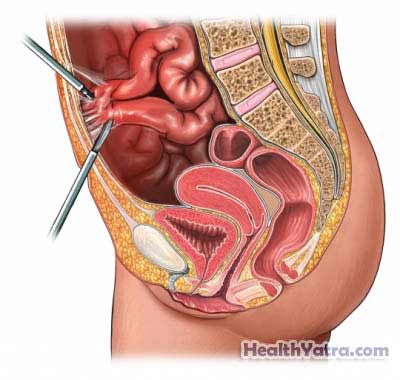परिभाषा
चिपकने वाले निशान हैं जो शरीर के भीतर बनते हैं। वे आमतौर पर पेट या श्रोणि में बनते हैं। उपचार प्रक्रिया के भाग के रूप में सर्जरी के बाद आसंजन स्वाभाविक रूप से विकसित होते हैं। वे संक्रमण या किसी अन्य भड़काऊ प्रक्रिया के बाद भी विकसित हो सकते हैं, जैसे:
- endometriosis
- विपुटीशोथ
- पथरी
आसंजनों का विश्लेषण शरीर के भीतर निशान ऊतक को काटने की प्रक्रिया है। यह सामान्य कार्य को बहाल करने और दर्द को कम करने के लिए किया जाता है।

प्रक्रिया के कारण
आसंजन पैदा कर सकता है:
- दर्द
- आंत्र की रुकावट
- बांझपन
This surgery can fix intestinal blockage and treat infertility caused by adhesions. It also reduces chronic abdominal pain in some individuals.
संभावित जटिलताएँ
Complications are rare, but no procedure is completely free of risk. If you are planning to have lysis of adhesions, your डॉक्टर एक सूची की समीक्षा करेंगे संभावित जटिलताओं में शामिल हो सकते हैं:
- अंगों में चोट
- बदतर आसंजन
- खून बह रहा है
- संक्रमण
जटिलताओं के जोखिम को बढ़ाने वाले कारकों में शामिल हैं:
- पहले से मौजूद हृदय या फेफड़ों की स्थिति
- मोटापा
- अतीत में पेट की बड़ी सर्जरी
- धूम्रपान
- मधुमेह
सर्जरी से पहले अपने डॉक्टर के साथ इन जोखिमों पर चर्चा करना सुनिश्चित करें।
क्या उम्मीद करें
प्रक्रिया से पहले
आपका डॉक्टर एक शारीरिक परीक्षा करेगा और इनमें से कुछ परीक्षणों का आदेश दे सकता है:
- रक्त और मूत्र परीक्षण
- Ultrasound —a test that uses sound waves to visualize the inside of the body
- CT scan —a type of x-ray that uses a computer to make pictures of the inside of the body
- MRI scan —a test that uses magnetic waves to make pictures of the inside of the body
सर्जरी के लिए अग्रणी:
- अपनी दवाओं के बारे में अपने डॉक्टर से बात करें। आपको प्रक्रिया से एक सप्ताह पहले तक कुछ दवाएं लेने से रोकने के लिए कहा जा सकता है, जैसे:
- विरोधी भड़काऊ दवाएं (जैसे, एस्पिरिन)
- क्लोपिडोग्रेल (प्लाविक्स) या वारफेरिन (कौमडिन) जैसे रक्त पतले
- अस्पताल से घर जाने के लिए सवारी की व्यवस्था करें। साथ ही, घर पर किसी की मदद करने की व्यवस्था करें।
- सर्जरी से एक रात पहले हल्का भोजन करें। आधी रात के बाद कुछ भी खाओ या पीओ मत।
बेहोशी
सामान्य एनेस्थीसिया - दर्द को रोकता है और सर्जरी के दौरान आपको सोता रखता है; आपके हाथ या बांह में IV के माध्यम से दिया जाता है
प्रक्रिया का विवरण
This surgery is usually done laparoscopically. After you are asleep and not feeling any pain, a needle will be inserted to inject a gas into the abdomen. The gas will make the abdomen expand. This will make it easier to see the organs. The laparoscope will then be inserted through a small hole that is cut in the skin. The laparoscope lights, magnifies, and projects an image onto a screen. The area will be inspected. The doctor will make several small incisions in the wall of the abdomen. Using small instruments that are put through these holes, the doctor will cut out the adhesions. Doing so will free the organs that were caught in the adhesions.
In some cases, the doctor may need to switch to open abdominal surgery (called laparotomy). The doctor will make a larger incision in the abdomen. This will allow direct access to all of the organs. The adhesions will be cut out.
इसमें कितना समय लगेगा?
1-3 घंटे
यह कितनी चोट पहुंचाएगा?
You will have soreness for a few days during recovery. If you needed खुली सर्जरी, you will have more pain. The doctor will give you pain medicine.
औसत अस्पताल में रहना
यह surgery is done in a hospital setting. If you have laparoscopic surgery, you will be able to leave that day or the next. If you have खुली सर्जरी, you will need to stay in the hospital for a few days. You may need to stay longer if you have complications.
प्रक्रिया के बाद की देखभाल
जब आप घर लौटना after the surgery, do the following to help ensure a smooth recovery:
- अपने डॉक्टर के निर्देशों का पालन करना सुनिश्चित करें।
- चीरे वाली जगह को साफ और सूखा रखें।
- अपने डॉक्टर से पूछें कि कब नहाना, स्नान करना या पानी में भिगोना सुरक्षित है।
- अपने चिकित्सक द्वारा निर्देशित दर्द की दवाएं लें।
- भारी सामान उठाने से बचें.
- दो दिनों तक कार्बोनेटेड पेय पदार्थ न पियें।
अपने डॉक्टर को बुलाओ
अस्पताल छोड़ने के बाद, यदि निम्न में से कोई भी हो तो अपने डॉक्टर से संपर्क करें:
- बुखार और ठंड लगने सहित संक्रमण के लक्षण
- लाली, सूजन, दर्द में वृद्धि, अत्यधिक रक्तस्राव, या चीरा स्थल से निर्वहन
- दर्द जिसे आप दी गई दवाइयों से नियंत्रित नहीं कर सकते
- मतली और/या उल्टी जिसे आप सर्जरी के बाद दी गई दवाओं से नियंत्रित नहीं कर सकते हैं, या जो अस्पताल से छुट्टी के बाद दो दिनों से अधिक समय तक बनी रहती है
- दस्त, कब्ज, खूनी मल या काला मल
- पेट में सूजन
- पेशाब करने में परेशानी
- खाँसी, साँस लेने में तकलीफ़, या सीने में दर्द
आपातकालीन स्थिति में तुरंत चिकित्सा सहायता के लिए कॉल करें।
